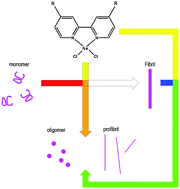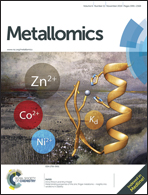Influence of gold–bipyridyl derivants on aggregation and disaggregation of the prion neuropeptide PrP106–126†
Abstract
Metal complexes can effectively inhibit the aggregation of amyloid peptides, such as Aβ, human islet amyloid polypeptide, and prion neuropeptide PrP106–126. Gold (Au) complexes exhibited better inhibition against PrP106–126 aggregation, particularly the Au–bipyridyl (bpy) complex; however, the role of different ligand configurations remains unclear. In the present study, three derivants of Au–bpy complexes, namely, [Au(Me2bpy)Cl2]Cl, [Au(t-Bu2bpy)Cl2]Cl, and [Au(Ph2bpy)Cl2]Cl, were investigated to determine their influence on the aggregation and disaggregation of PrP106–126. The steric and aromatic effects of the ligand resulted in enhanced binding affinity. Inhibition was significantly affected by a large ligand. The neurotoxicity of the SH–SY5Y cells induced by PrP106–126 was reduced by the three Au–bpy derivants. However, the disaggregation ability was not in accordance with the results obtained for selected complexes during inhibition, suggesting a different mechanism of interaction between gold complexes and PrP106–126. The key peptide residues contributed to both the inhibition and disaggregation capabilities through the metal coordination and the hydrophobic interaction with the metal complexes. Thus, understanding the aggregation mechanism of the prion peptide would be helpful in designing novel metal-based drugs against amyloid fibril formation.


 Please wait while we load your content...
Please wait while we load your content...